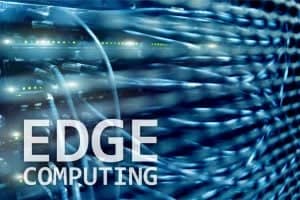
Project Frontier is a Dell Technologies initiative to build an edge operations software platform that will allow companies across any industry to securely scale their edge operations for any use case.
The edge is critical for improving business outcomes. However, many organizations face challenges when trying to scale their edge operations. RTInsights recently sat down with Jeroen Mackenbach, Technical Staff, Engineering Technologist, and Varun Taware, Product Marketing, Edge Solutions, from Dell Technologies, to discuss operational, management, and security issues organizations face with edge and how the recently announced Project Frontier by Dell Technologies can help.
Here is a summary of our conversation.
RTInsights: Why is the edge so important to so many industries today?
Mackenbach: Organizations have a need to increase their productivity and operational efficiency. On top of that, many organizations also must meet increasing expectations for better customer experiences. All these objectives are best achieved by utilizing the edge rather than backhauling all data to the data center to process it. Also, there are security and compliance requirements that organizations must meet. A platform that can support these requirements is crucial for these customers.
Taware: Edge as a concept is not new. People have been implementing instrumentation initiatives for decades. That was the old variation of edge technology. Back then, people deployed data loggers and sensors to collect data and process it after the fact. They were not facilitating real-time decision-making.
But today’s edge technologies are dramatically different. Now, the edge is where people can generate something of immediate and essential value near the point of data creation. This is a paradigm shift that enables insights in real time that were not possible before. This, in turn, facilitates some critical decision-making capabilities to drive strong business outcomes. Organizations want to embrace this new realm of possibilities.
Additionally, the desire for the edge today is fueled by the explosion of different technologies like AI/ML and compute infrastructure devices of different form factors and ruggedized capabilities that can easily fit in small remote spaces. These technologies enable real-time processing at the edge instead of trying to bring that back into a data center and processing it after the fact.
![Securely Scale Edge Operations to Power Any Use Case [Learn More]](https://no-cache.hubspot.com/cta/default/8019034/8e223d82-c56a-4229-b2d9-66dfc8bfcbfe.png)
Now, with the growth of software-defined storage and software defined-networking at the edge, organizations are able to scale up, meaning they can start small and expand as their needs increase.
RTInsights: What are the major challenges when organizations try to implement edge applications at scale?
Mackenbach: The environment and the hardware mix that we see at the edge are diverse. A lot of locations are hard to reach or are only reached once to do the installment. The systems must work in energy-challenging environments, some are outside or dusty, and they must have extended temperature requirements. So, that’s one challenge.
We also see that there are a lot of very traditional operation technology application workloads at the edge. There are applications that were designed years back and still need to be sustained over time. They’re going to be there for years to come. So, that’s another challenge.
Also, we see that a lot of these systems are distributed systems in terms of operations. It’s sensors communicating with networks, networks communicating with servers, servers communicating with servers, and it’s a distribution all over the globe and even up to the cloud.
Another challenge with the edge is that the systems can be tucked under the counter at retail stores, or they’re stuck in local machines. There are many people that potentially could physically access these devices, or in other locations, there will never be anyone able to access it after its installment. There’s not an actual IT department supporting these locations. If you’re lucky, you have someone on-site that could power cycle it, but that’s about it. In these situations, you bring in the device, and it needs to operate for the rest of its life.
So, remote capabilities are essential, and there’s the security bit as well. Because the devices are not in a data center, there’s no IT to service the devices and no security system or person to control access to the devices. So, access to these points is crucial, and that’s what we need to take into consideration when we design platforms. Silos and proliferation in these environments are very common. Many challenges for customers to do this at scale, and Dell is well-positioned to help these customers.
Taware: I’ll add to that. IT admins are entrenched in the data center’s ways of doing things. And many people feel like the edge is just an extension of the data center. But if you get into real complex edge deployments, you realize that the edge has a unique set of challenges that require a new way of imagining your architectures to solve the challenges.
For example, as Jeroen mentioned, whether you are on a factory floor or even in the stores, the environmental conditions of edge locations are absolutely different compared to what you see in the data centers. Edge is not just an extension of the data center. You basically need to support the operational technology workloads in these remote environments.
If you are looking at workloads that are coming from the equipment on the factory floor, they probably have a totally different way of communicating, such as BACnet and other protocols. Another thing, the data center is full of IT experts. That is not the case with the edge. You don’t see IT admins walking down the factory floor, the aisles of retail stores, or in the energy plants. These locations do not have local IT experts. So, you need to be able to sustain your edge operations in far-edge locations without relying on local IT expertise.
Another point to consider is that there are so many different vendors. Each vendor probably has a different level of security built into the product. And your security is only as good as your weakest link. So, you are always at risk of getting exposed to cyberattacks as your edge expands. And so, security becomes a growing concern.
And lastly, I want to call out the proliferation of silos across the edge. In the past, each location may have taken a piecemeal approach to its edge initiatives. But that approach is not scalable beyond that site. Consequently, those solutions end up running in a silo which creates inconsistent ways of doing things based on different locations, sites, or stores.
So, when we think of edge deployment, all these challenges come to the forefront.
RTInsights: With the explosive growth of IoT devices on the operations floor, technology teams are faced with challenges around data management, scalability, monitoring, and real-time performance. What’s driving this, and how can these challenges be overcome?
Taware: If you look at the overarching trends on the technology and data side, we see large amounts of data being created by data sources, most of which have never existed before. We have data being generated from sensors, robotics, video sources, IoT devices, and more. These devices and data sources have exploded onto the scene in recent years. In the past, a business might collect data every minute or every 30 seconds, max, but nothing was near the real-time capabilities we see today.
Second, a new generation of technologies has matured that promise to enable us to derive value from that data in near real time. Technologies such as advances in AI modeling paired with small form factor computing and low latency 5G networking enable us to capture, curate, analyze, and act faster than ever before.
![Securely Scale Edge Operations to Power Any Use Case [Learn More]](https://no-cache.hubspot.com/cta/default/8019034/8e223d82-c56a-4229-b2d9-66dfc8bfcbfe.png)
Now, managing this data and processing it in real time presents several challenges. There is a need to connect disparate devices and equipment, manage the data streams with different formats and protocols, build real-time actionable insights driven by AI/ML, and scale these efforts across factory sites consistently.
To overcome these challenges, you need to simplify the adoption and deployment of technologies that make this real-time processing of massive data possible. You need compute and storage solutions that are resilient, extremely fast, compact, and ruggedized to perform in harsh edge environments. At a lower level of data processing, you need solutions that enable high-speed data ingestion and unconstrained storage at the edge—something that provides the ability to run ML training models at the edge using limitless historical data for playback. Further, you will need an ecosystem of applications to provide the desired targeted analytics and visualizations out of the box.
RTInsights: What are some of the key technology areas that can help?
Mackenbach: We want to make sure that we have a simplified edge operation. So, technologies like zero-touch onboarding, centralized management, fleet management, and continuous operations are key items that are important for our customers.
Also, customers want to optimize their edge investments and freedom of choice. Consolidating technology silos can protect legacy IT investments as they move along. They also want zero-trust security and hardware integrity. For instance, secure component validation, as Dell has it, is very important for customers to ensure that the supply chain is not compromised.
RTInsights: How do Dell and Project Frontier help?
Mackenbach: Project Frontier is our initiative to build an edge operations software platform that will allow companies across any industry to securely scale their edge operations for any of their use cases. To help illustrate this in a real-world example, we designed a video using a retail use case.
Taware: Adding to that, what we are trying to do with this platform is to simplify the edge operations at scale. By that, we mean we want our customers to be able to leverage automation and AI/ML capabilities to streamline edge deployment and operations without the need for an IT expert in the field. And whether your operations are located in a single building or if it expands across the globe, you should be able to manage and visualize it centrally from a single pane of glass. If new devices need to be added to it, it should be very streamlined, with little to no human intervention required to set up and onboard those devices.
After setup, lifecycle management tasks need to be automated so that you don’t have to worry about doing those same tasks thousands of times for each of those devices. Project Frontier streamlines and takes care of it for you.
Another thing we are trying to accomplish with this edge platform is compatibility. We are building this platform to be open and vendor-agnostic by design. We will enable our customers to optimize the edge investment they already have in place at their edge.
They will have the freedom to choose the technologies they want to deploy at the edge. They will have the flexibility to choose an IoT application framework from vendors of their choice. If they have a home-grown application, which will be the case for large enterprises, they do not have to discard those applications if they move to this platform.
Organizations will be able to select the OT vendor that currently exists or works best for their sites across different regions.
We give them that flexibility. Further, we can containerize or virtualize those workloads and get them all running on the singular, homogenous architecture of this platform. With this, you have a consistent way of scaling and managing your application workloads. It will protect your legacy IT investment in a sense that, say, if you have something that is working, secure, and robust, you can continue working with it.
And finally, all this simple streamlining and simplifying operations and giving you that open design to optimize your existing edge investment will amount to nothing if we do not ensure security. And for that, the platform is being built with zero-trust security principles at its core. Zero-trust security is all about continuous validation and testation of every resource that is connected to the edge.
Whether it’s a device or an application, it’s all being continuously validated to ensure it is compliant, provides a secure operating environment to run the application workload, is not tampered with, and meets all the relevant security requirements. It ensures hardware integrity while it fortifies the data and the applications that run at the edge.
RTInsights: Can you share some examples of how you’re helping customers today with this?
Mackenbach: One way we are helping is with validated designs. For instance, we have our validated designs with Litmus and PTC, and we’re expanding that also to validated designs for retail use cases and soon-to-be other verticals as well.
![Securely Scale Edge Operations to Power Any Use Case [Learn More]](https://no-cache.hubspot.com/cta/default/8019034/8e223d82-c56a-4229-b2d9-66dfc8bfcbfe.png)
Next to that, we’re extending the Dell portfolio hardware-wise. That means we have launched our Dell Edge Gateways, the 3200 and the 5200, and we have launched the Dell PowerEdge XR4000 platform. And what we’re envisioning is we will complement everything with Project Frontier, which is planned to launch mid-year.
Taware: As part of our effort to build the edge platform, we have kicked off what we call the edge design program. Our goal with the program is to collaborate with our customers to understand what their edge deployments and challenges look like to make sure that our platform is built with flexibility and openness to support a wide range of variations in the use cases and deployment challenges. As a company, you’ll see us continue expanding from products that help customers design, build, and manage edge solutions to additional solutions that help them simplify their edge. Looking to the future, we believe Project Frontier will help customers win at the edge in the years to come.
Project Frontier is a Dell Technologies initiative to build an edge operations software platform that will allow companies across any industry to securely scale their edge operations for any use case.





























